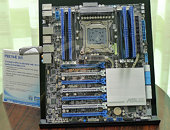- Joined
- Oct 9, 2007
- Messages
- 47,670 (7.43/day)
- Location
- Dublin, Ireland
| System Name | RBMK-1000 |
|---|---|
| Processor | AMD Ryzen 7 5700G |
| Motherboard | Gigabyte B550 AORUS Elite V2 |
| Cooling | DeepCool Gammax L240 V2 |
| Memory | 2x 16GB DDR4-3200 |
| Video Card(s) | Galax RTX 4070 Ti EX |
| Storage | Samsung 990 1TB |
| Display(s) | BenQ 1440p 60 Hz 27-inch |
| Case | Corsair Carbide 100R |
| Audio Device(s) | ASUS SupremeFX S1220A |
| Power Supply | Cooler Master MWE Gold 650W |
| Mouse | ASUS ROG Strix Impact |
| Keyboard | Gamdias Hermes E2 |
| Software | Windows 11 Pro |
It looks like the void left by lack of socket LGA1150 motherboards is being filled by new LGA2011 HEDT ones, with ASUS joining in with the P9X79-E WS. The board is so big and feature-packed that its designers labeled it a workstation board that's built in the SSI-CEB form-factor (should fit in full-ATX cases that have room for EATX). The board features a 10-phase CPU VRM, seven PCI-Express 3.0 x16 slots, which are wired to the CPU through a couple of 48-lane PCI-Express bridge chips, support for 128 GB quad-channel DDR3 memory, six SATA 6 Gb/s ports (two from the X79 PCH, four from third-party controllers), four SATA 3 Gb/s ports, a couple of eSATA 6 Gb/s ports, four USB 3.0 ports, FireWire, 8-channel HD audio, and two gigabit Ethernet interfaces, which are each backed by Intel-made PHYs.

View at TechPowerUp Main Site

View at TechPowerUp Main Site






 I'd rather have the beefier VRMs though. There are a lot of really nice things on this board though. For example all of the fan headers are 4-pin PWM, and there are something like 6 of them.
I'd rather have the beefier VRMs though. There are a lot of really nice things on this board though. For example all of the fan headers are 4-pin PWM, and there are something like 6 of them.
